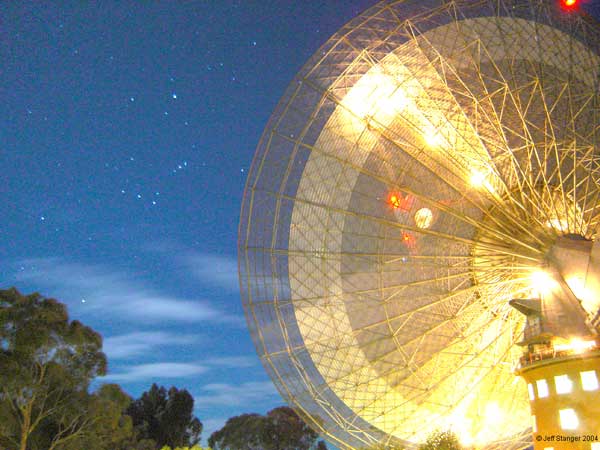
Behind The Scenes At The Dish
The Parkes Radio Telescope, or The Dish, is one of the worlds finest radio telescopes. I was lucky enough to be able to spend a week getting to know this icon of the astronomical world in 2004. This telescope collects radio waves from space and gives astronomers an invaluable window to vast and exotic regions of the universe. As well as being a valuable asset to the scientific community, The Dish is an incredibly beautiful and inspiring structure. It was a privilege to experience the everyday running of this facility and the people who do such an amazing job of utilizing and maintaining it.
I took many pictures while I was there and I hope that you like the story of my stay and the great things I saw in my time there (if you haven't guessed already, I'm a big astronomy nut so you'll have to excuse me if I sound a bit excited).
Let the eye feast begin!
I thought the dish looked impressive during the day but that was nothing compared to the view at night and once I worked out how to use my new camera I got a few good shots.
The constellation of Orion visible with the dish as it observes pulsars in the Orion arm of our galaxy
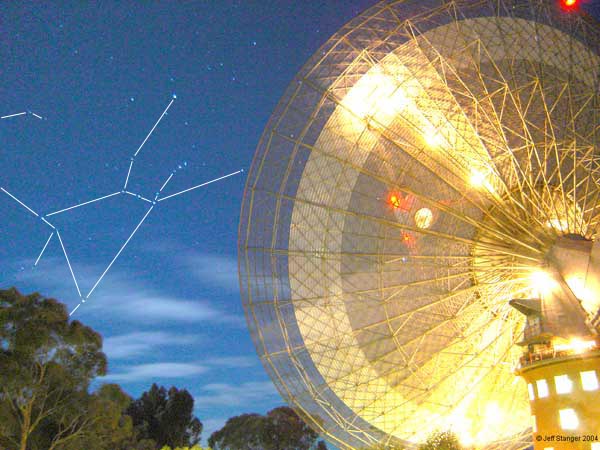
The Rey diagram for Orion outlines most of the great hunter
On the other side of the telescope the big dog (Canis Major) rises, upside down of course : )
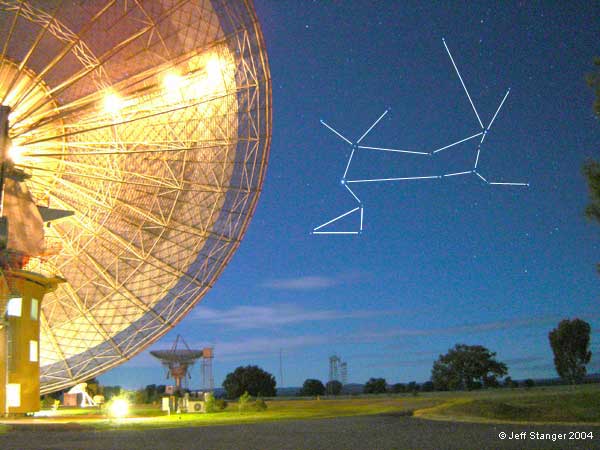
And there he is defying gravity and with the blood rushing to his head at an amazing rate
Looking west, the dish bathed in moonlight
(Clicking on the hyperlinked images above will download a 1050 x 788 desktop sized image)
Now it wasn't all fun and games, there was some work involved.
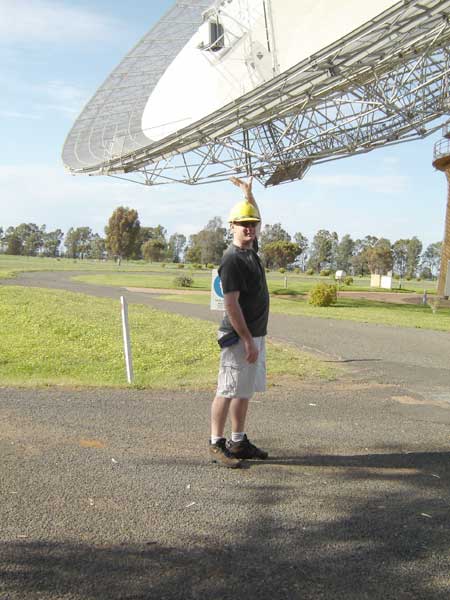
I was put to good use straight away (You can tell I was thinking, I hope someone else comes to take a turn soon, my arm is tired)
When they finally told me that I really didn't have to hold the dish (they were so cruel) I staggered into the control room to chat to Steve.
Click on the image above to see a bigger version, but only if you dare, Steve's up to something with that cheeky grin on his face.
Now that I had seen the control room I was wondering how they pointed this monster.
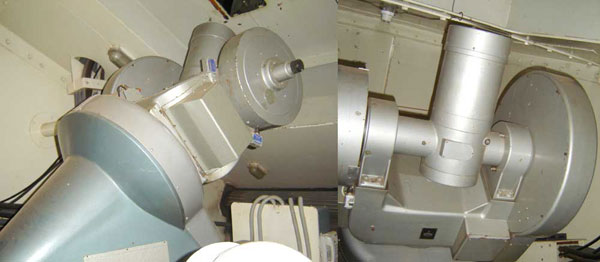
They use this little optical telescope called the master equatorial buried deep within the heart of the dish. The dish itself follows this little telescope, which essentially points the main dish when you want to look at an object in the sky and allows it to track the object as it moves across the sky.
Now they told me there was a really big computer in these cabinets.
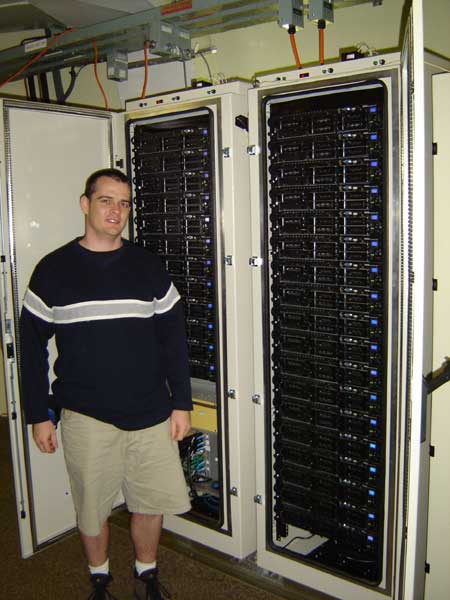
Since I'm such a propeller head they had to give me a look to stop me nagging them.
Then they told us that there was more cool stuff up this ladder in the focus cabin.

Once I had taken a sufficient amount of medication, off we went.
All those lights and switches, can't I just press one, pleeease?
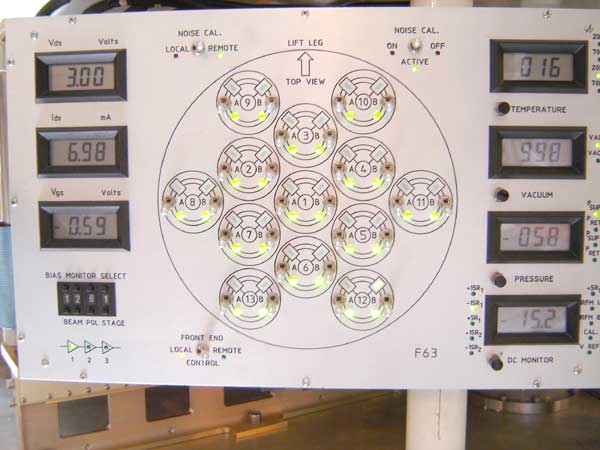
Check out the temperature readout in the top right corner, I wish I had a freezer that could reach -257 degrees C.
The control panel above is for the 13 beams of the multibeam receiver (before installation below).

This receiver has allowed the Parkes radio telescope to discover more pulsars than all the other radio telescopes in the world combined.
This is the "front end" where the signals are amplified and "down-converted" to allow transmission to the control room below

Hmm, more buttons and switches, ... must ... not ... touch ... them.
We quickly got up on the roof to stop me touching anything, check out that view.
Click on the image above to see a bigger version, but if your afraid of heights, don't look down.
Too late I looked down :(
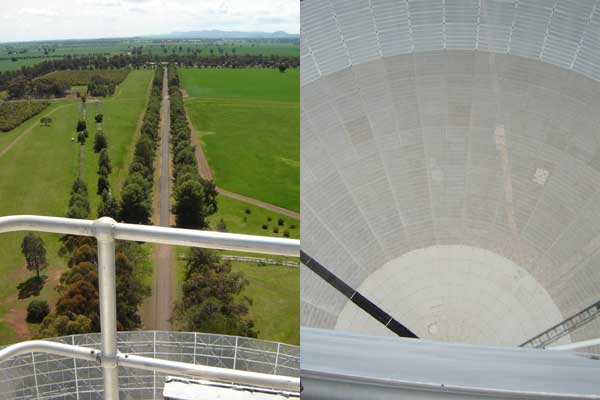
Note to self, don't drop the camera and stop shaking or the pictures will be blurry
Next was the decent.
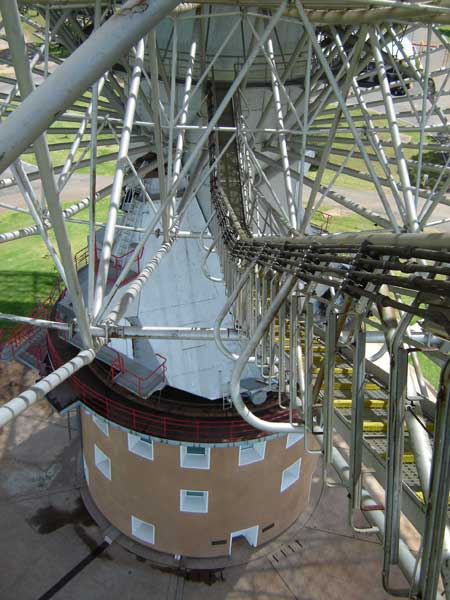
I'm not shaking, honest, I just had too much coffee this morning, really : (
Back down stairs the "back end" of the telescope is where the signals are manipulated according to what the astronomers are trying to study. Below are various outlets from the front end (left), signal generators (left) and the correlator banks (right).
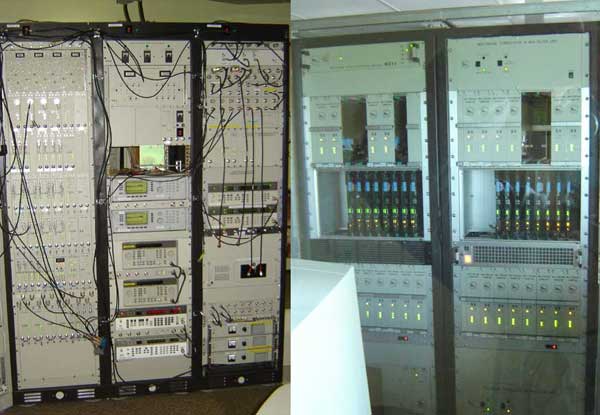
We did some head scratching while we were trying to trace the signal path through the system.
Now time is important when you are looking at things like Pulsars. Talk about techo, both an atomic and a maser clock feed time signals into the system here (left) and on the right is the southern hemisphere's SETI search Southern SERENDIP.

I just stood for ages watching the time tick over in tiny fractions of a second. It's just all too nerdy for words.
Here's where the old meets the new

For those who like to keep it "old school" style there were even some manual controls for those moments when we need to feel that computers don't run the world.
Now this shot gives you an idea of just how big this monster is and where we went on our climb.
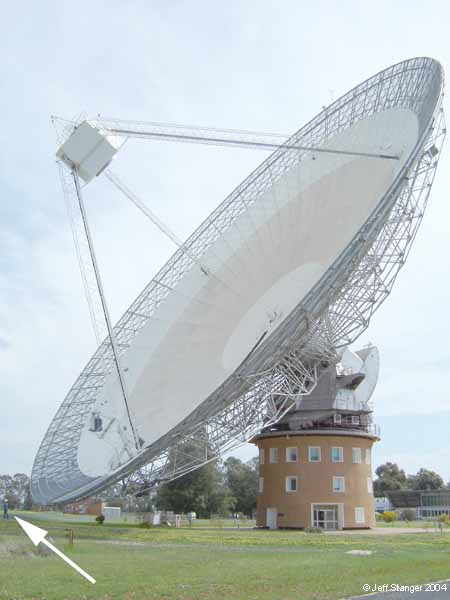
Notice my offsider Julia is being followed by a giant arrow while she tries to provide a reference scale.
After all this running around it was time for us to take a break.
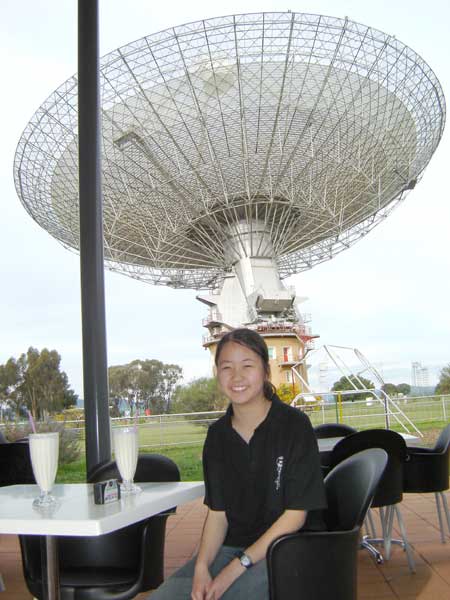
With a low RFI (Radio Frequency Interference) milk shake (i.e. hand shaken because blenders emit radio waves).
On a later trip we took another route onto the dish, the hay ride.
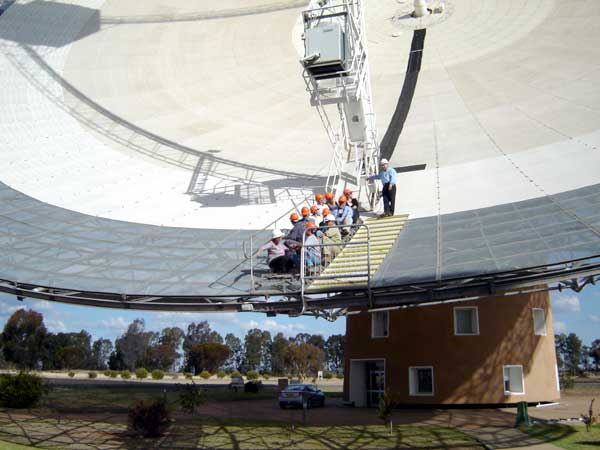
This way involved less stairs :)
Once the dish was in the stowed position we checked out the huge parabolic surface
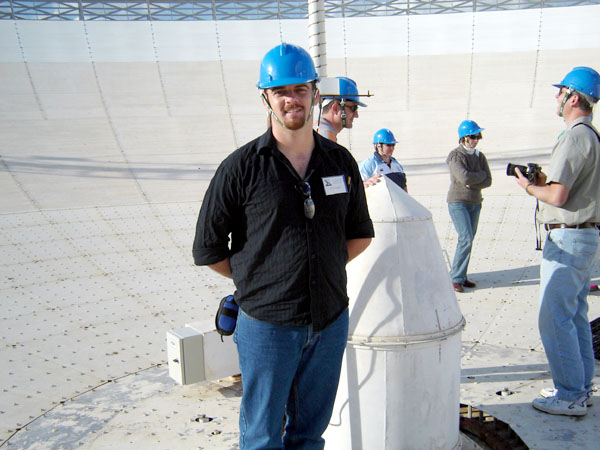
Unfortunately we forgot our cricket gear
Looking up towards the focus cabin.
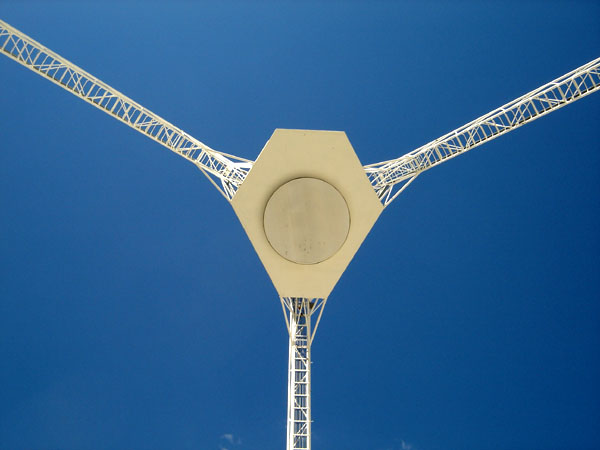
You get a sense of the last thing a radio photon sees before it has to stand up and be counted.
The Dish did show its feminine side too.
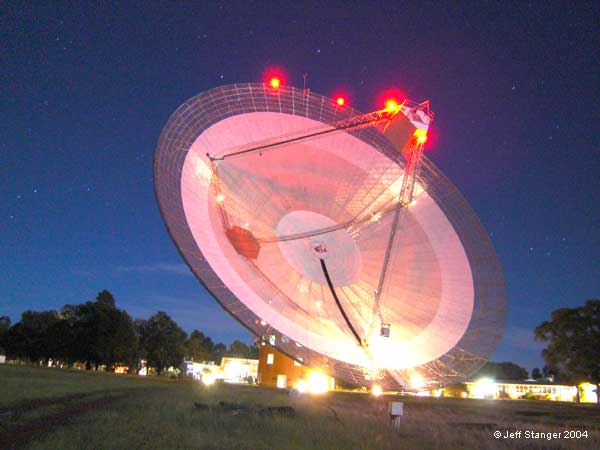
One for the girls in a lovely shade of pink.
Now don't tell anyone, but I just had to write on the dish to leave my mark.
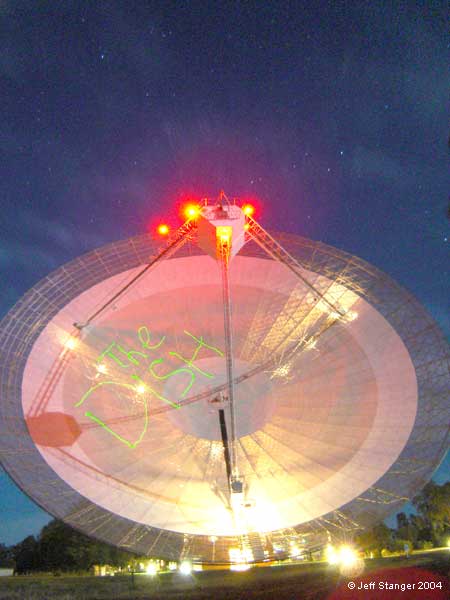
After a few practice goes I got pretty good at green laser light graffiti.
The dish put on a light show of its own while it was moving in this image.
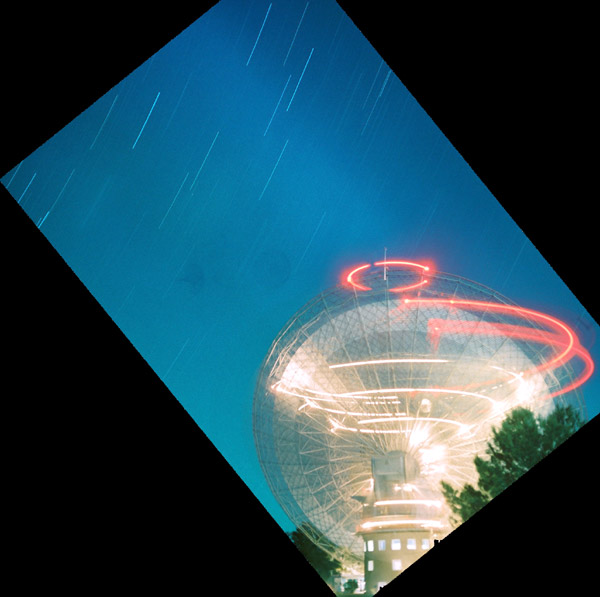
In the sky trailing behind the dish is the centre of our galaxy in the constellation of Sagittarius.
Sadly I had to leave and I stopped to reflect on my experiences.
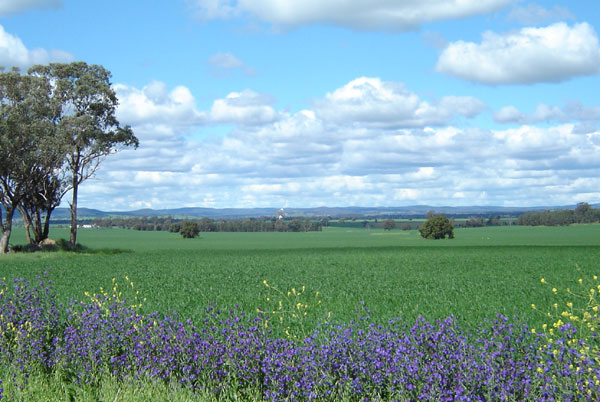
The dish carried on reflecting those radio waves and pretended not to miss me.
Until my next astronomy adventure
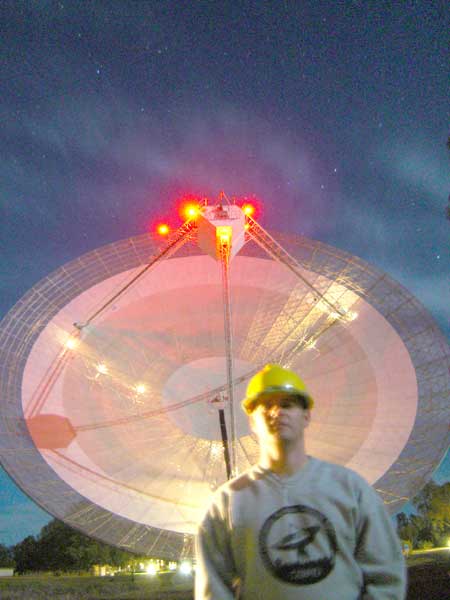
It's back to optical astronomy and small telescopes : (
So ends my light hearted look at my time at The Dish. Please stay tuned for informative additions on the interesting projects that I observed being carried out by the astronomers while I was there. Pulsars, pulsars, pulsars and a touch of emission line observing of star forming regions.
Further Information
To find out about some of the astronomers I met and their projects you can take a look at the following links
http://www.astro.columbia.edu/~fernando/
http://www.atnf.csiro.au/research/pulsar/
http://astronomy.swin.edu.au/pulsar/
http://www.jb.man.ac.uk/~pulsar/
To find out more about the Parkes Observatory try these ones
http://www.outreach.atnf.csiro.au/
http://www.parkes.atnf.csiro.au/
To find out more about the multibeam receiver, the HIPASS survey and Pulsars try the following
http://www.atnf.csiro.au/research/multibeam/
http://www.csiro.au/index.asp?type=imageDef&id=hipassSurvey1
http://www.atnf.csiro.au/research/pulsar/wwwdev/Education_page.html
The Dish | Home | Astronomy | Astrophotography | Science | Space Science | Astrobiology | Science Teaching | Related Links | Contact Me